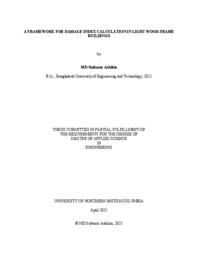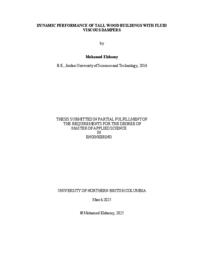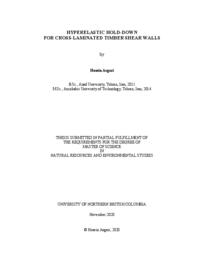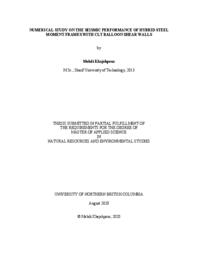Iqbal, Asif
Person Preferred Name
Asif Iqbal
Related Works
Content type
Digital Document
Origin Information
Content type
Digital Document
Origin Information
Content type
Digital Document
Origin Information
Content type
Digital Document
Description / Synopsis
Cross-laminated timber (CLT) continues to establish a stronger footing in the Canadian construction industry, also as an option for lateral load resisting systems, such as shear walls. Recent modifications to the Canadian Standard for Engineering Design in Wood (CSA O86- 19) allow only rocking kinematics as energy dissipative mechanics for CLT shear walls, whereby hold-down must remain elastic. These provisions necessitate the development of novel hold-down solutions. In this report, the performance of a hyper-elastic high-capacity hold-down was investigated at the component level through tests on: (1) hold-down steel rod, (2) CLT housing, and (3) hold-down assemblies with different sizes of rubber pads. The tests demonstrated that: i) the rubber hold-down can remain elastic under a rocking kinematics provided that the elastic limit of the steel rod is not exceeded; ii) failure of the rod is the subsequent desired ductile mode; iii) the CLT width influences the failure mode; iv) the shape factor influences the achievable deformation of the rubber pad; v) increasing the rubber pad thickness reduces the hold-down stiffness; and vi) increasing the rubber pad width increases the hold-down stiffness. Numerical modelling and optimization suggested that using an intermediate steel laminate between layers of rubber pads could improve its performance. Based on the results of the investigations presented herein, a capacity-design procedure for the hyper-elastic hold-downs was proposed.
Origin Information
Content type
Digital Document
Description / Synopsis
Cross-laminated Timber (CLT) is increasingly being used in tall buildings. However, there are some challenges when designing high-rise CLT structures, amongst them the need for novel hold-downs (HD), for shear walls. While commonly used HDs behave as a dissipative connection, the current Canadian Standard for Engineering Design in Wood recommends designing HDs as a non-dissipative connection. As hyperelastic material, an elastomer (rubber) is capable to carry high loads without inelastic deformation. This thesis presents experimental studies at material- and component-levels using a hyperelastic rubber HD solution for CLT walls. A total of 53 quasi-static monotonic and cyclic tests were performed. The HDs exhibited high strength and deformation capacity without any residual deformation after unloading. The shape factor and loaded area of rubber layers were found as the main effective factors on the rubber HD’s response, and an empirical load-displacement relation was also developed based on these parameters.
Origin Information
Content type
Digital Document
Description / Synopsis
The widespread availability of Cross-laminated timber (CLT) provides opportunities to extend the use of wood beyond traditional low-rise residential construction. Glued-in rods (GiR) are an interesting technical solution for numerous structural applications in timber engineering. Although GiR connections have the potential to be used in combination with CLT, research on this application is scarce. In this thesis, an experimental investigation on the performance of GiR in CLT is presented. Two different 5-ply CLT panel thicknesses (139 and 175 mm), two steel rod diameters (d = 12.7 and 19.1 mm) and five different anchorage lengths (la = 6d, 10d, 12d, 14d and 18d) were considered in single and multiple rod connections. A total of 260 specimens were fabricated and subsequently tested under uni-axial quasi-static monotonic tension. The results were assessed in terms of load-carrying capacity, stiffness and failure modes and demonstrated that GiR in CLT offer an alternative high capacity timber connection.
Origin Information
Content type
Digital Document
Description / Synopsis
A proposed hybrid lateral load resisting system combining a moderately ductile steel moment resisting frame (SMRF) with Cross-laminated Timber (CLT) balloon-framed shear walls is investigated on 8, 12 and 16-storey case-study buildings using equivalent static, linear dynamic (modal), nonlinear static (push-over) and nonlinear dynamic (time history) analyses. First, a SMRF is designed using ETABS, then the hybrid structures are analysed in OpenSees. By adding the CLT shear wall to steel moment frame, the period of structure decreased and its stiffness increased. The time history analyses result revealed that by adding the CLT shear wall the maximum drift decreased, while the maximum base shear in hybrid structure slightly increased. The hold down uplift forces under earthquake records are reported and compared to each other. Using push-over capacity-curves, a ductility reduction factor of 3.6, an over strength factor of 1.57 and a seismic response modification factor of 5.67 are derived.
Origin Information







